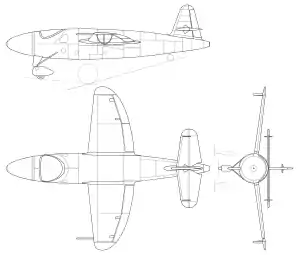Heinkel He 176
The Heinkel He 176 was a German rocket-powered aircraft. It was the world's first aircraft to be propelled solely by a liquid-fueled rocket, making its first powered flight on 20 June 1939 with Erich Warsitz at the controls. It was a private venture by the Heinkel company in accordance with director Ernst Heinkel's emphasis on developing technology for high-speed flight. The performance of the He 176 was not spectacular, but it did provide "proof of concept" for rocket propulsion.
| He 176 | |
|---|---|
 | |
| Post war artist impression of the He 176 | |
| Role | Experimental |
| Manufacturer | Heinkel |
| First flight | 20 June 1939 |
| Status | Cancelled |
All documents regarding the He 176 were destroyed during the war. The Warsitz autobiography suggests material is in the Soviet/Russian archives. The often quoted performance data of the aircraft, such as a speed reaching 750 km/h, or 800 km/h in Warsitz's autobiography, as well as some of the drawings, are not based on sound documents. Only two true pictures of the He 176 have survived which were probably taken in Peenemünde during tests.[1]
Design and development
During the 1920s, German daredevils had experimented with using solid-fuel rockets to propel cars, motorcycles, railway carriages, snow sleds, and, by 1929, aircraft such as Alexander Lippisch's Ente and Fritz von Opel's RAK.1. Solid-fuel rockets, however, have major disadvantages when used for aircraft propulsion, as their thrust cannot be throttled, and the engines cannot be shut down until fuel is exhausted.
In the late 1930s, Wernher von Braun's rocketry team working at Peenemünde investigated installing liquid-fuelled rockets in aircraft. Heinkel enthusiastically supported their efforts, supplying a He 72 and later two He 112s for the experiments. In early 1937, one of these latter aircraft was flown with its piston engine shut down during flight, at which time it was propelled by rocket power alone. At the same time, Hellmuth Walter's experiments into Hydrogen peroxide monopropellant-based rockets were leading towards light and simple rockets that appeared well-suited for aircraft installation, although at the price of considerable danger and limited duration.
The He 176 was built to utilise one of the new Walter engines. It was a tiny, simple aircraft, built almost entirely out of wood, but did possess an advanced, totally enclosed cockpit, with a frameless single-piece clear nose, through which the pilot's rudder pedal mounts were visible, and the landing gear was a combination of conventional and tricycle gear designs, with the main gear's struts intended to retract rearwards into the fuselage, with a fixed, aerodynamically faired nose wheel and strut, a clumsy plexiglas bubble installed after the pilot entered the plane as described by Warsitz and shown, barely, in the one take off photograph, which cockpit was built around Warsitz's frame, and a retractable tail wheel.[2] The drawing here shows a flush glazing. There is no evidence this was actually used. A unique feature of the He 176 was its jettisonable nose escape system. Compressed air was used to separate the nose from the aircraft. A drogue chute was used to reduce the opening force required. After the drogue was deployed, the flush-fitting cockpit canopy was released and a conventional pilot/parachute bailout occurred.[3]
Heinkel demonstrated the aircraft to the RLM, but official lack of interest led to the abandonment of the company's rocket propulsion programme. Testing of the He 176 ended with only one aircraft being built. It was put on display at the Berlin Air Museum and was destroyed by an Allied bombing raid in 1943.[3]
Prior to the cancellation of the programme, plans had been drawn up for a more sophisticated rocket-plane, the hypothetical He 176 V2. This was never constructed, but because it bore the same designation as the aircraft that was actually flown, many books and websites mistakenly publish pictures of it to illustrate its earlier namesake. This is primarily the post war Gerd Heumann airbrush job and the basis for this is unknown.
Germany did eventually fly an operational rocket-propelled fighter, the Alexander Lippisch-designed Me 163 Komet, but this was made by the competing Messerschmitt firm, using an engine that was a further development of the one that powered the He 176.
Specifications (He 176 V1)

Data from Heinkel:An aircraft album[4]
General characteristics
- Crew: 1
- Length: 5.21 m (17 ft 1 in)
- Wingspan: 5.00 m (16 ft 5 in)
- Height: 1.435 m (4 ft 8.5 in)
- Wing area: 5.4 m2 (58 sq ft)
- Empty weight: 900 kg (1,985 lb)
- Gross weight: 1,620 kg (3,572 lb)
- Powerplant: 1 × Walter HWK R1-203 liquid-fuelled rocket engine, 5.88 kN (1,323 lbf) thrust , 50 s burn time
Performance
- Maximum speed: 750 km/h (466 mph, 405 kn) estimated
- Cruise speed: 710 km/h (441 mph, 383 kn) estimated
- Range: 109 km (68 mi, 59 nmi)
- Service ceiling: 9,000 m (29,500 ft)
- Rate of climb: 60.6 m/s (11,930 ft/min)
- Time to altitude: 2.5 minutes to 8,000 m (26,250 ft)
References
- Volker Koos, Heinkel He 176 – Dichtung und Wahrheit, Jet&Prop 1/94 p. 17–21
- Tuttle, Jim. Eject! The Complete History of U.S. Aircraft Escape Systems. St. Paul, Minnesota: MBI Publishing Company, 2002. ISBN 0-7603-1185-4.
- St. John Turner, P. (1970). Heinkel:An aircraft album. Shepperton: Ian Allan. pp. 100–101. ISBN 07110 01731.
External links
| Wikimedia Commons has media related to Heinkel He 176. |